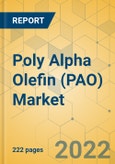Speak directly to the analyst to clarify any post sales queries you may have.
This report considers the present scenario of the poly alpha olefin market and its market dynamics for 2022−2027. It covers a detailed overview of several market growth enablers, restraints, and trends. The study covers both the demand and supply sides of the market. It also profiles and analyses leading companies and several other prominent companies operating in the market.
The global poly alpha olefin market is expected to grow at a CAGR of 4% during 2022-2027
KEY HIGHLIGHTS
- The major factor driving the growth of the market is the increasing demand for better performance engine oils that result in lower CO2 emissions and higher-performing lubricants for industrial equipment.
- However, being a synthetic base oil, it faces a major threat from bio-based lubricants, which are experiencing rapid growth.
- Europe dominated the global polyalphaolefin market with a share of around 42.71% in terms of revenue in 2021. The region is expected to witness a significant CAGR of 4.32% by revenue.
MARKET OPPORTUNITIES AND TRENDS
- Increasing Demand from Automotive Sector
- Demand for Vehicles with Higher Fuel Economy
MARKET GROWTH ENABLERS
- Growing Demand from Electric Vehicles
GLOBAL POLY ALPHA OLEFIN MARKET SEGMENTATION
Low viscosity PAOs accounted for the largest market share in the global polyalphaolefin market by type. This segment holds a 51.90% share and is expected to grow at a CAGR of 4.4% between 2021 and 2027.
Segmentation by Type
- Low Viscosity
- High Viscosity
- Medium Viscosity
Segmentation by End-Use
- Automotive
- Industrial
- Others
VENDOR LANDSCAPE
In APAC, China represents a lucrative growth opportunity owing to the booming automotive industry and strong presence of manufacturing facilities. In addition, low cost of production and availability of raw material at a cheaper cost attracts global players to set up their manufacturing base in China.
Key Vendors
- British Petroleum
- Exxon Mobil Corporation
- Ineos
- Shell
Other Prominent Vendors
- Addinol
- Croda International
- Chemtura
- ENI
- Fuchs
- Idemitsu Kosan
- Liqui Moly
- Lukoil
- Lubricon
- Labdhi Chemicals
- Mitsui Chemicals
- Naco Synthetics
- Novvi
- PetroCanada
- Penrite Oil
- Peak Lubricants
- Shanghai FOX Chemical Technology
- Sasol
- Tulstar Products
- Valero
GEOGRAPHICAL ANALYSIS
- Europe dominated the global polyalphaolefin market with a share of around 42.71% in terms of revenue in 2021. The region is expected to witness a significant CAGR of 4.32% by revenue.
- The prime factor supporting the growth of the European region is the well-established automotive industry that consumes a major chunk of polyalphaolefins.
Segmentation by Geography
- North America
- US
- Canada
- Europe
- Germany
- UK
- France
- Spain
- Italy
- Rest of Europe
- APAC
- China
- India
- Japan
- South Korea
- Indonesia
- Rest of Asia Pacific
- Rest of the World (ROW)
THE REPORT INCLUDES:
1. The Analysis of The Global Poly Alpha Olefin (PAO) Market Size and Growth Rate for The Forecast Period 2022-2027.
2. It Offers Comprehensive Insights into Current Industry Trends, Trend Forecast, And Growth Drivers About the Global Poly Alpha Olefin (PAO) Market.
3. The Report Provides the Latest Analysis of Market Share, Growth Drivers, Challenges, And Investment Opportunities.
4. It Offers a Complete Overview of Market Segments and The Regional Outlook of The Poly Alpha Olefin (PAO) Market.
5. The Report Offers a Detailed Overview of The Vendor Landscape, Competitive Analysis, And Critical Market Strategies to Gain Competitive Advantage.
Table of Contents
Companies Mentioned
- British Petroleum
- Exxon Mobil Corporation
- Ineos
- Shell
- Addinol
- Croda International
- Chemtura
- ENI
- Fuchs
- Idemitsu Kosan
- Liqui Moly
- Lukoil
- Lubricon
- Labdhi Chemicals
- Mitsui Chemicals
- Naco Synthetics
- Novvi
- PetroCanada
- Penrite Oil
- Peak Lubricants
- Shanghai FOX Chemical Technology
- Sasol
- Tulstar Products
- Valero
Methodology
Our research comprises a mix of primary and secondary research. The secondary research sources that are typically referred to include, but are not limited to, company websites, annual reports, financial reports, company pipeline charts, broker reports, investor presentations and SEC filings, journals and conferences, internal proprietary databases, news articles, press releases, and webcasts specific to the companies operating in any given market.
Primary research involves email interactions with the industry participants across major geographies. The participants who typically take part in such a process include, but are not limited to, CEOs, VPs, business development managers, market intelligence managers, and national sales managers. We primarily rely on internal research work and internal databases that we have populated over the years. We cross-verify our secondary research findings with the primary respondents participating in the study.

LOADING...








